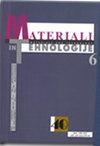电池应用中连接技术的当代进展综述
IF 0.8
4区 材料科学
Q4 MATERIALS SCIENCE, MULTIDISCIPLINARY
引用次数: 0
摘要
多层箔与导电片的连接需要在电池中进行连接过程,而电池是可再生能源领域的重要存储设备。电池、模块和电池组是连接在电池组中的三个级别的小袋电池。多层不同导电材料的连接是制造电池组的必要条件。铜(Cu)和铝(Al)主要用于电池组应用。铜和铝具有高导热和高导电性的特点。然而,使用传统方法获得高质量的铜铝焊缝是困难的,并且焊缝的耐久性是不确定的。一般来说,由于化学和物理性质的差异,金属间化合物(IMCs)在焊接过程中的发展是不同材料连接的主要挑战。这篇综述讨论了电池组和连接导电片所涉及的挑战。此外,本综述还提供了对各种连接工艺的适用性的见解,并探讨了它们在电池组连接中的适用性。本文章由计算机程序翻译,如有差异,请以英文原文为准。
A CONTEMPORARY REVIEW OF THE ADVANCEMENTS IN JOINING TECHNOLOGIES FOR BATTERY APPLICATIONS
The joining of multilayered foils to a conductive tab necessitates a joining process in the battery, which is an important storage device in renewable-energy sectors. Cell, module, and pack are the three levels of pouch cell joining in a battery pack. The joining of multi-layered dissimilar conductive materials is necessary for battery-pack fabrication. Mostly copper (Cu) and aluminium (Al) are used in battery-pack applications. The Cu and Al are characterized as high thermally and electrically conductive materials. However, obtaining a quality Cu-Al weld using conventional methods is hard and the durability of the weldments is uncertain. In general, the development of intermetallic compounds (IMCs) during welding is a major challenge for the joining of dissimilar materials due to the differences in the chemical and physical properties. This review addresses the battery packs and challenges involved in joining the conductive tabs. In addition, this review provides an insight into the suitability of various joining processes and explores their suitability for the joining of battery packs.
求助全文
通过发布文献求助,成功后即可免费获取论文全文。
去求助
来源期刊

Materiali in tehnologije
工程技术-材料科学:综合
CiteScore
1.30
自引率
0.00%
发文量
73
审稿时长
4-8 weeks
期刊介绍:
The journal MATERIALI IN TEHNOLOGIJE/MATERIALS AND TECHNOLOGY is a scientific journal, devoted to original papers and review scientific papers concerned with the areas of fundamental and applied science and technology. Topics of particular interest include metallic materials, inorganic materials, polymers, vacuum technique and lately nanomaterials.
 求助内容:
求助内容: 应助结果提醒方式:
应助结果提醒方式:


